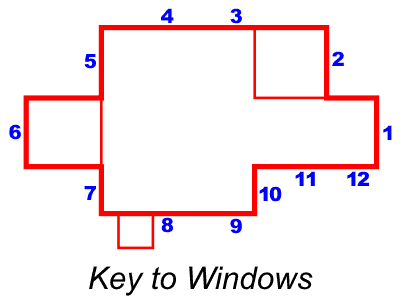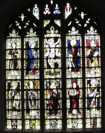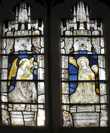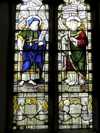For this church:    |
|
| To the glory of God, and in memory of Samuel Benjamin Browne, Rector of Plumtree, A.D. 1883-1906. |
7 South
aisle west window
South
aisle west window
This modern window is by Christine Bodicombe, a pupil of the artist John Piper, who died in 1968 at the age of 28. The colours and lettering are based on those used in the 12th century. The window, which was installed in 1963, was commissioned by and gifted to the church by Mr G D Johnson in memory of his wife, Doris Constable Johnson, and two of their daughters. Mr Johnson was a churchwarden at Radcliffe on Trent parish church but moved to the south of England when he retired. When visiting his son he worshipped at Plumtree. His son, Philip, later served for 27 years as a churchwarden at St Mary’s. The elder daughter, Geraldine, died in the early years of the second world war of a streptococcal virus having been a nurse. She is buried in Bulcote churchyard. The second daughter, Noelle, died at the age of two just after the first world war of the ‘sleeping sickness’. She is buried in St Giles’ Church, West Bridgford. The Rector, Arnold Doxey, chose the text for this window, ‘Lord, I have loved the habitation of Thy House’, as Mr Johnson and his wife never missed their Sunday worship. There are four roundels depicting the minsters of York, Lincoln and Southwell and the parish church of Plumtree. (Nottinghamshire was originally included in the Diocese of York, but in 1837 was transferred to the Diocese of Lincoln; the Diocese of Southwell was created in 1884.)
9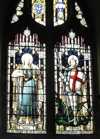 South
aisle, eastmost window
South
aisle, eastmost window
Designed and made by studio of Edward Reginald Frampton, who was trained at the well known firm of Clayton & Bell. The original tracery lights were removed and replaced by angel figures, to match those in the adjacent aisle window, by Burlison & Grylls. This may have been to allow the Order of the Star of India insignia to be included.
10 Lady
Chapel window
Lady
Chapel window
The four figures of the Greek Doctors (Gregory, Basil, Athanasius and Chrysostom) are closely based on figures in a window in the Lorenzkirche in Nuremburg dating from the second half of the 15th century. The Annunciation in the upper part of the window is also based on German medieval figures. The window dates from about 1880.



